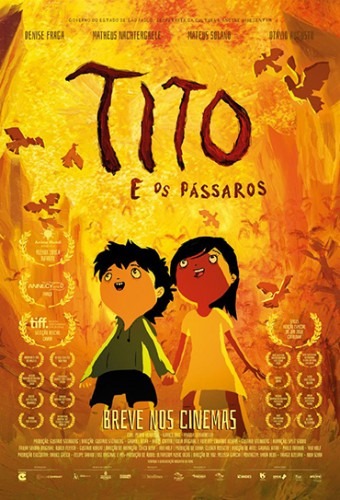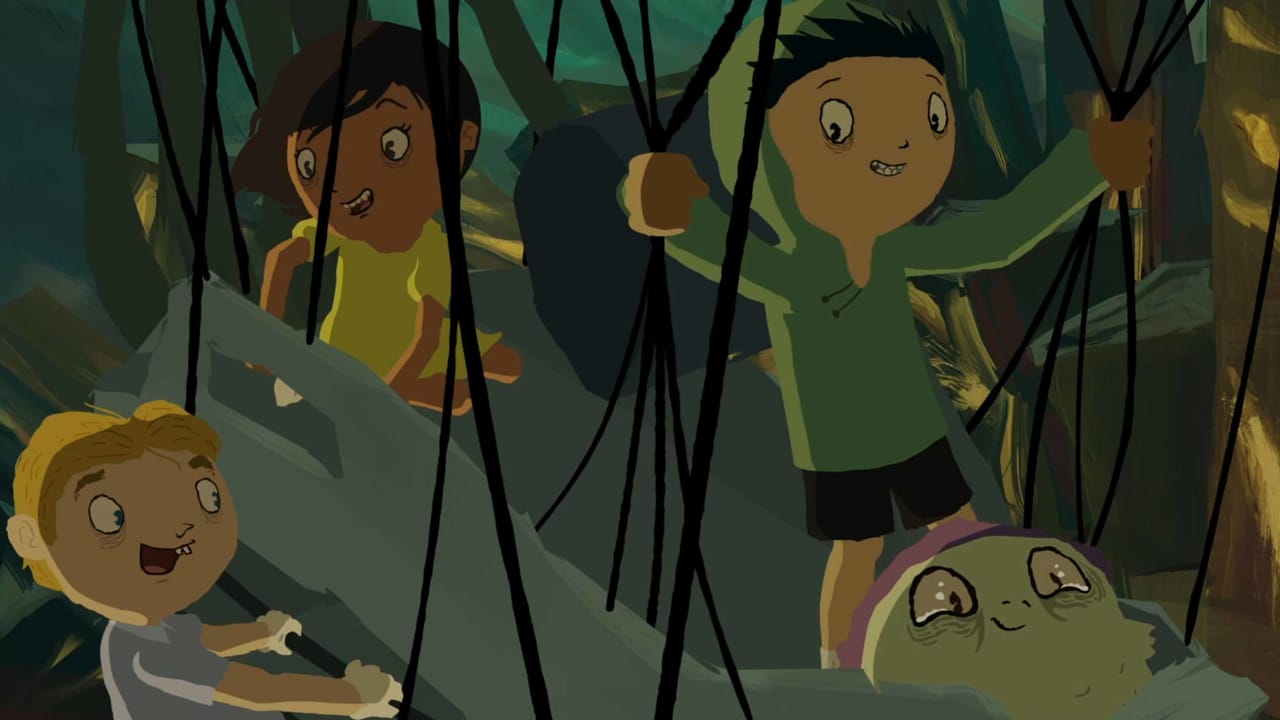
Fear itself
First published, with slight alterations, at the Film Experience. Presented now during the film's limited release in the U.S.
First things first: the Brazilian animated feature Tito and the Birds is a preposterously beautiful motion picture. The film's style is perhaps best described as looking like a digital oil painting, with swirling smears of color defining every background and character. It is not by any stretch of the imagination looking to present a realistic vision of the world; rather, it creates spaces defined only in outlines and crude shapes, and then filled in with dramatic swatches of barely-motivated reds and yellows and blues that function expressively and emotionally rather than to build out the narrative. It is, at an absolute minimum, one of the most eccentric, distinctive animated features created in 2019, but it's not just eccentric: the aesthetic is thoughtful, consistent, and pairs elegantly with the film's thematic concerns.
Those concerns are pretty overt, to the point that it almost feels like the film is a bit of a diatribe. Tito fashions itself as something of a Young Person's Guide to Media Skepticism, using several traits of children's cinema (bright colors, 10-year-old protagonists who are social misfits, an idealised missing parent, talking animals of a sort) to package a plot about how easy it is for corporate news media to control and corrupt the inner lives of the everyday citizens who rely on that media. You can pick which modern-day companies and which modern-day governments they prop up that reminds you of, but the film doesn't need that level of specificity to function effectively as a commentary on life under capitalism.
The society within the film is one in which fear has become something very like a communicable disease, the symptoms of which include sufferers trembling, losing control of their body, and shrinking into paralyzed, curled-up husks, functionally no different than large rocks. The fanciful nature of the disease and its visual representation notwithstanding, the filmmakers are presenting a fairly straightforward interpretation of memetic theory: ideas can be transmitted by watching other people express those ideas. The fear outbreak at the center of Tito is fundamentally ironic and self-reflexive: people are so afraid of becoming afraid that the catch the very fear disease they're being warned to avoid. The cure is to avoid listening to the self-serving demagogues who have figured out how to best line their own pockets and boost their own power by triggering that weaponized fear process intentionally.
This is hardly elegant or obscure message-making, but it's surely an open question whether it needs to be. It is a kids' movie, after all. It's also a pointedly slender adventure movie, coming in at all of 73 minutes long. That latter fact, in particular, makes it easy to think of this above all as a parable or fable, as if the openly fantastic elements didn't already push us that way (the plot involves Tito, a young boy with a missing father and a fear-stricken mother, inventing a machine that will allow him to speak with birds, the only animals that might have the knowledge to stop the fear epidemic). And it is the privilege of parables to have exactly one moral lesson that they hit the audience with, hard and fast.
Besides, Tito and the Birds has an awfully tasty spoonful of sugar to help with its medicine. The film's style is extraordinary rich and complex, despite the obvious attempts at doing something that will stay on budget. Like a great deal of 2-D animation in the 2010s, this has been made on some Flash-style software that locks in the characters as something akin to paper dolls: every body part is rigid and tied together at the joints. Thankfully, though, Tito combats the stiffness that sometimes results from this technique by using a whole lot of joints, including animating the characters' hair as separate from their head. The results still lack a certain organic quality, and possess Flash's mildly uncanny impression that the characters are "floating" on the backgrounds, but the film compensates for it in part with the constancy of movement. This is a busy, hectic movie in which people are constantly running about, and in which the camera itself (that is to say, the "camera") darts around hallways, executing elaborate pans and tilts that look up and tilt on the side while also moving backwards.
The sense of constant, twitchy motion is a perfect fit for the wiry nervousness of the plot and themes, while the clarity of the digital medium gives the simulacrum of expressionistic oil paintings a boldness and brightness that pairs well with the film's strong, angry response to the cruelty and avarice of its villains. Simple and obvious though it might be, Tito and the Birds is also striking and passionate, one of the most excitingly fresh features from an exceptionally strong year for animation.
First things first: the Brazilian animated feature Tito and the Birds is a preposterously beautiful motion picture. The film's style is perhaps best described as looking like a digital oil painting, with swirling smears of color defining every background and character. It is not by any stretch of the imagination looking to present a realistic vision of the world; rather, it creates spaces defined only in outlines and crude shapes, and then filled in with dramatic swatches of barely-motivated reds and yellows and blues that function expressively and emotionally rather than to build out the narrative. It is, at an absolute minimum, one of the most eccentric, distinctive animated features created in 2019, but it's not just eccentric: the aesthetic is thoughtful, consistent, and pairs elegantly with the film's thematic concerns.
Those concerns are pretty overt, to the point that it almost feels like the film is a bit of a diatribe. Tito fashions itself as something of a Young Person's Guide to Media Skepticism, using several traits of children's cinema (bright colors, 10-year-old protagonists who are social misfits, an idealised missing parent, talking animals of a sort) to package a plot about how easy it is for corporate news media to control and corrupt the inner lives of the everyday citizens who rely on that media. You can pick which modern-day companies and which modern-day governments they prop up that reminds you of, but the film doesn't need that level of specificity to function effectively as a commentary on life under capitalism.
The society within the film is one in which fear has become something very like a communicable disease, the symptoms of which include sufferers trembling, losing control of their body, and shrinking into paralyzed, curled-up husks, functionally no different than large rocks. The fanciful nature of the disease and its visual representation notwithstanding, the filmmakers are presenting a fairly straightforward interpretation of memetic theory: ideas can be transmitted by watching other people express those ideas. The fear outbreak at the center of Tito is fundamentally ironic and self-reflexive: people are so afraid of becoming afraid that the catch the very fear disease they're being warned to avoid. The cure is to avoid listening to the self-serving demagogues who have figured out how to best line their own pockets and boost their own power by triggering that weaponized fear process intentionally.
This is hardly elegant or obscure message-making, but it's surely an open question whether it needs to be. It is a kids' movie, after all. It's also a pointedly slender adventure movie, coming in at all of 73 minutes long. That latter fact, in particular, makes it easy to think of this above all as a parable or fable, as if the openly fantastic elements didn't already push us that way (the plot involves Tito, a young boy with a missing father and a fear-stricken mother, inventing a machine that will allow him to speak with birds, the only animals that might have the knowledge to stop the fear epidemic). And it is the privilege of parables to have exactly one moral lesson that they hit the audience with, hard and fast.
Besides, Tito and the Birds has an awfully tasty spoonful of sugar to help with its medicine. The film's style is extraordinary rich and complex, despite the obvious attempts at doing something that will stay on budget. Like a great deal of 2-D animation in the 2010s, this has been made on some Flash-style software that locks in the characters as something akin to paper dolls: every body part is rigid and tied together at the joints. Thankfully, though, Tito combats the stiffness that sometimes results from this technique by using a whole lot of joints, including animating the characters' hair as separate from their head. The results still lack a certain organic quality, and possess Flash's mildly uncanny impression that the characters are "floating" on the backgrounds, but the film compensates for it in part with the constancy of movement. This is a busy, hectic movie in which people are constantly running about, and in which the camera itself (that is to say, the "camera") darts around hallways, executing elaborate pans and tilts that look up and tilt on the side while also moving backwards.
The sense of constant, twitchy motion is a perfect fit for the wiry nervousness of the plot and themes, while the clarity of the digital medium gives the simulacrum of expressionistic oil paintings a boldness and brightness that pairs well with the film's strong, angry response to the cruelty and avarice of its villains. Simple and obvious though it might be, Tito and the Birds is also striking and passionate, one of the most excitingly fresh features from an exceptionally strong year for animation.






